The Dwarfing Effects of Different Plant Growth Retardants on Magnolia wufengensis L.Y. Ma et L. R. Wang
Abstract
1. Introduction
2. Materials and Methods
2.1. Study Area
2.2. Study Design
2.2.1. Dwarfing Experiment of the PGRs
2.2.2. Supplemental Dwarfing Experiments at Different Uniconazole Concentrations
2.3. Method
2.3.1. Morphological Investigation
2.3.2. Determination of Physiological and Biochemical Indicators
2.3.3. Determination of Endogenous Hormones
2.4. Data Processing
3. Results
3.1. Dwarfing Effects of PGRs on Morphology
3.2. Dwarfing Effects of PGRs on Physiology
3.3. Dwarfing Effects of PGRs on Endogenous Hormones
3.4. Effects of Different Concentrations of Uniconazole on Morphology
3.5. Effects of Different Concentrations of Uniconazole on Physiology
3.6. Effects of Different Concentrations of Uniconazole on Endogenous Hormones
4. Discussion
4.1. Dwarfing Effects of PGRs on Morphology
4.2. Dwarfing Effects of PGRs on Physiology
4.3. Effects of PGRs on Endogenous Hormones
5. Conclusions
Author Contributions
Funding
Data Availability Statement
Conflicts of Interest
References
- Ma, L.Y.; Wang, L.R.; He, S.C.; Liu, X.; Wang, X.Q. A new species of Magnolia (Magnoliaceae) from Hubei, China. Bull. Bot. Res. 2006, 26, 4–7. [Google Scholar]
- Ma, L.Y.; Wang, L.R.; He, S.C.; Liu, X.; Wang, X.Q. A new variety of Magnolia (Magnoliaceae) from Hubei, China. Bull. Bot. Res. 2006, 26, 516–519. [Google Scholar]
- Liang, D.W. Select on Superior Tree Magnolia wufengensis and Cultivar Classification; Forestry University: Beijing, China, 2010. [Google Scholar]
- Sang, Z.Y.; Ma, L.Y.; Chen, F.J.; Zhang, P.; Zhu, Y.C. Protection status and utilization countermeasure of germplasm resources of the Magnolia wufengensis in Wufeng County. Hubei Agric. Sci. 2011, 50, 1564–1567. [Google Scholar]
- Shi, X.D.; Ma, L.Y.; Duan, J.; Sang, Z.Y.; Zhu, Z.L.; Yao, N.; Zhou, M.M.; Jia, Z.K. Potential climatically adaptive regions for the introduction of Magnolia wufengensis. J. Zhejiang A F Univ. 2018, 35, 705–715. [Google Scholar]
- Wang, B.; Ma, Y.; Chen, G.; Li, C.; Dao, Z.; Sun, W. Rescuing Magnolia Sinica (Magnoliaceae), a critically endangered species endemic to Yunnan, China. Oryx 2016, 50, 446–449. [Google Scholar]
- Bai, L.J.; Yin, S.X. Progress on Origins and Mechanism of Dwarfish Plants Mutant. Biotechnol. Bull. 2014, 6, 34–39. [Google Scholar]
- Qin, S.Q.; Yang, J.J. High-yield cultivation techniques for Juglans regia dwarfing and dense planting. Deciduous Fruits 2015, 47, 46–48. [Google Scholar]
- Yang, F.Y.; Guan, H.C.; Zhang, Z.; Hao, R.M.; Dong, S.J. Introduction to several apple dwarf rootstocks. Deciduous Fruits 2014, 46, 53–54. [Google Scholar]
- Huang, J.S.; Wu, Z.W.; Yu, H.G. Dwarfing effect of large branch pruning of Myrica tinctorius in Dingdai county. South China Fruits 2009, 38, 16–17. [Google Scholar]
- Chen, Z.M.; Du, G.J.; Hu, W.B.; Chen, W.; Zhang, Y.X.; Ying, Y.D. Effect of Plant Growth Regulators on Dwarfing of Potted Osmanthus fragrans. J. Zhejiang For. Sci. Tech. 2012, 32, 53–56. [Google Scholar]
- Zhang, Y.Y.; Yu, M.L.; Ma, R.J.; Cai, Z.X.; Shen, Z.J.; Xu, J.L. Identification of SRAP markers linked to peach gene with the character of tall normal/brachytic dwarf. J. Fruit Sci. 2011, 28, 586–590. [Google Scholar]
- Zhao, Y.L.; Li, C.C.; Chen, X. Effect of 60Co-γ Radiation on the Dwarfing Mechanism of Rhododendron decorum. North. Hortic. 2012, 19, 48–50. [Google Scholar]
- Huang, H.Y.; Zhong, F.L.; Zhang, F.Y.; Cao, M.H.; Yang, B.Y.; Lin, Y.Z. Paclobutrazol application in horticultural plants. Subtrop. Agric. Res. 2011, 7, 37–41. [Google Scholar]
- Cui, H.Y.; Huang, X.G.; Xin, B.J.; Zhang, Q.Y.; Yu, H.X.; Liu, Q.D. The use of Paclobutrazol on the young Apple trees. J. Fruit Sci. 1996, 13, 84–87. [Google Scholar]
- Wei, M.B.; Wei, R.X. Paclobutrazol Application in Fruit-tree. Beijing Agric. 2009, 9, 51–54. [Google Scholar]
- Pan, R.C. Physiological and applications of the plant growth retarders. J. S. China Norm. Univ. Nat. Sci. 1984, 2, 121–129. [Google Scholar]
- Kumawat, G.L.; Swaroop, K.; Janakiram, T.; Jain, R. Induction of dwarfing in bougainvillea cv Mahara by use of growth regulators. Indian J. Agric. Sci. 2014, 84, 802–807. [Google Scholar]
- Porlingis, I.C.; Voyiatzis, D.G. Influence of paclobutrazol plant growth regulator on vegetative and reproductive growth of olive (Olea Europaea L.). Acta Hortic. 1986, 179, 587–588. [Google Scholar]
- Aron, Y.; Monselise, S.P.; Goren, R.; Costo, J. Chemical control of vegetative growth in Citrus trees by paclobutrazole. HortScience 1985, 20, 96–98. [Google Scholar]
- Chen, S.H.; Lin, X.P.; Chen, Y.; Zheng, Y.N. The influence of dminozide and paclobutrazol of Sapindus mukorossi Gaertn growth. J. Ningde Normal Univ. Nat. Sci. 2014, 1, 7–10. [Google Scholar]
- Wang, G.; Xiao, J.Z.; Li, Z.B.; Bai, X.X. The influence of paclobutrazol on physiological characteristics of Rhododendron hybrides leaves. J. Agric. Univ. Hebei 2010, 33, 50–53. [Google Scholar]
- Wang, X.Y.; Ma, C.Z.; Li, X.D. Effects of paclobutrazol on content of polyamines in peanut leaves and leaf senescence. Acta Bot. Boreal. Occident. Sin. 2001, 21, 323–328. [Google Scholar]
- Xu, K.; Li, S.Z. The effects of irrigation and PP333 on the growth and seed yield of Agropyron smithii. Pratacult. Sci. 2011, 28, 1291–1295. [Google Scholar]
- Wei, S.L.; Chang, L.B.; Wang, Z.J.; Wang, X.N. Inhibitory effect of the preliminary test of Paclobutrazol on the growth of new shoots of persimmon. Sci. Tech. Vis. 2015, 2, 385–386. [Google Scholar]
- Gao, S.R.; Zhao, Z.G.; Hou, J.L.; Wang, W.Q.; Song, Y.; Yan, B.B.; Jin, Y.Q. Effects of plant growth regulator uniconazole on plant morphology and biomass allocation of Salvia miltiorrhiza. China J. Chin. Mater. Med. 2015, 40, 1925–1929. [Google Scholar]
- Wheaton, T.A. Triazole bioregulators reduce internode length and increase branch angle of Citrus. Acta Hortic. 1989, 239, 277–280. [Google Scholar] [CrossRef]
- Yang, W.Y.; Han, H.F.; Ren, W.J.; Zhao, L.; Fan, G.Q. Effects of Uniconazole Waterless-dressing Seed on Endogenous Hormones and C/N Ratio at Tillering Stage of Wheat. Acta Agron. Sin. 2005, 31, 760–765. [Google Scholar]
- Bakheta, M.A.; Hussein, M.M. Uniconazole effect on endogenous hormones, proteins and proline contents of barley plants (Hordium vulgare) under salinity stress (NaCl). Nusant. Biosci. 2014, 6, 2087–3948. [Google Scholar]
- Tao, L.X.; Wang, X.; Yu, M.Y.; Huang, X.L.; Xu, R.S. Effects of environmental conditions on degradation of S-07 and PP333 in soil. Acta Agric. Zhejiangensis 1997, 9, 246–250. [Google Scholar]
- Ouzounidou, G.; Ilias, I.; Giannakoula, A.; Papadopoulou, P. Comparative study on the effects of various plant growth regulators on growth, quality and physiology of Capsicum annuum L. Pak. J. Bot. 2010, 42, 805–814. [Google Scholar]
- Kang, S.M.; Kim, J.T.; Hamayun, M. Influence of prohexadione calcium on growth and gibberellins content of Chinese cabbage grown in alpine region of South Korea. Sci. Hortic. 2010, 125, 88–92. [Google Scholar] [CrossRef]
- Andreotti, C.; Costa, G.; Bucchi, F.; Bazzi, C. Growth regulation and reduced fire blight incidence in pear induced by Prohexadione-Ca [Pyrus communis L.-Emilia-Romagna]. Atti V Giornate Sci. SOI 2000, 10, 71–86. [Google Scholar]
- Pan, M.J.; Yin, Y.Q.; Shen, F.K.; Luo, B.X.; Tang, X.L.; He, H.H.; Chen, D.K. Effects of prohexadione calcium on physiological index of Tobacco seedlings during cold stress. Southwest China J. Agric. Sci. 2016, 29, 288–293. [Google Scholar]
- Zhao, S.J.; Liu, H.S.; Dong, X.C. Plant Physiology Experiment Guide; China Agricultural Press: Beijing, China, 1997. [Google Scholar]
- Zhang, Z.L.; Qu, W.J. Experiment Guide for Plant Physiology, 3rd ed.; Higher Education Press: Beijing, China, 2003. [Google Scholar]
- Gao, J.F. Experimental Guidance for Plant Physiology; Higher Education Press: Beijing, China, 2006. [Google Scholar]
- Li, H.S. Principles and Techniques of Plant Physiological Biochemical Experiment; Higher Education Press: Beijing, China, 2000; pp. 194–197. [Google Scholar]
- Xiao, A.H.; Chen, F.J.; Jia, Z.K.; Sang, Z.Y.; Zhu, Z.L.; Ma, L.Y. Determination of 4 plant hormones in Magnolia wufengensis by gradient elution high performance liquid chromatography. Chin. J. Anal. Lab. 2020, 39, 249–254. [Google Scholar]
- Wójcik, P. Response of ‘red delicious’ apple trees drip-fertigated with ammonium nitrate to application of silicic acid. Sci. Hortic. 2019, 249, 15–21. [Google Scholar] [CrossRef]
- Cohen, Y.; Aloni, D.D.; Adur, U.; Hazon, H.; Klein, D.J. Characterization of growth-retardant effects on vegetative growth of date palm seedlings. J. Plant Growth Regul. 2013, 32, 533–541. [Google Scholar] [CrossRef]
- Roux, S.L.; Barry, G.H. Vegetative growth responses of citrus nursery trees to various growth retardants. Hortic. Tech. 2010, 20, 197–201. [Google Scholar] [CrossRef]
- Mao, Y.Q.; Zheng, Q.S.; Chen, J.M.; Liu, Z.P.; Liu, G.H.; Jiang, C.Q. Physiological mechanism of foliage spraying paclobutrazol on increasing salt tolerance of Jatropha curcas Seedlings. Acta Ecol. Sin. 2011, 31, 4334–4341. [Google Scholar]
- Xiang, J.L.; Huang, Y.L.; Yin, K.D.; Liu, Z.B.; Xu, Y.M.; Feng, J.S.; Ren, H.J. Effect of S3307 on anti-oxidant enzyme activity and DNA methylation level of coix seedlings under drought stress. Chin. J. Biol. 2017, 29, 264–270. [Google Scholar]
- Qin, P.; Liu, F.H.; Liang, X.N. Superoxide dismutase and plant resistance to the environmental stress. Heilongjiang Agric. Sci. 2002, 1, 31–34. [Google Scholar]
- Du, X.M.; Yin, W.X.; Zhang, H.; Zhao, Y.X. The Researching Progress of Superoxide Dismutase. J. Chin. Biotechnol. 2003, 23, 48–50. [Google Scholar]
- Dou, J.H.; Yu, S.X.; Fan, S.L.; Pang, C.Y.; Song, M.Z. Sod and plant stress resistance. Mol. Plant Breed. 2010, 8, 359–364. [Google Scholar]
- Chen, Y.L.; Cao, M.; Li, Y.Y.; Zhou, Y. Effect of Fulvic Acid on ABA, IAA and Activities of Superoxide Dismutase and Peroxydase in Winter Wheat Seedling Under Drought Condition. Plant Physiol. Commun. 2000, 36, 311–314. [Google Scholar]
- Zuo, W.B.; Wu, J.L.; Yang, Q.; Zhang, J.N.; Liu, G.R. Study on the influence of root of different wheat varieties under drought stress. Acta Agric. Boreal. Occident. Sin. 2010, 25, 191–193. [Google Scholar]
- Zhang, M.S.; Xie, B.; Tan, F.; Zhang, Q.T. Relationship Among Soluble Protein, Chlorophyll and ATP in Sweet potato Under Water Stress with Drought Resistance. Sci. Agric. Sin. 2003, 36, 13–16. [Google Scholar]
- Lin, Y.; Guo, W.Z.; Xu, Z.H.; Jia, Z.X. Cold Resistance and Changes on MDA and Soluble Sugar of Leaves of Ligustrunlucidum Ait in Winter. Chin. Agric. Sci. Bull. 2012, 28, 68–72. [Google Scholar]
- Li, Y.B.; Yang, S.Q.; Ren, G.X.; Feng, Y.Z.; Zhang, Q.; Li, P. Changes analysis in physiological properties of several gramineous grass species and cold -resistance comparison on under cold stress. Acta Ecol. Sin. 2009, 29, 1341–1347. [Google Scholar]
- Zhou, X.L. Studies on the Dwarfing Effect of PP333 and SS3307 to Chlorophytum Capense ‘Vittatum’; Zhejiang University: Hangzhou, China, 2017. [Google Scholar]
- Nie, L.; Xie, J.B.; Liang, Y.M. Improve cold-resistance of Zoysia tenuifolla in winter by plant growth retardants. Pratacul. Sci. 2003, 20, 63–65. [Google Scholar]
- Wang, H.S.; Sun, H.M. The Research on Plant Growth Retardants Improving Drought Resistance of Solanum Integrifolium Poir. Chin. Agric. Sci. Bull. 2012, 28, 126–132. [Google Scholar]
- Liu, G.; Fei, Y.J.; Tu, M.; Ding, Z.L. Effects of CCC and DPC on the cold resistance of phoebe bournei. Hubei Agric. Sci. 2015, 54, 1403–1406. [Google Scholar]
- Grossmann, K. Plant growth retardants as tools in physiological research. Physiol. Plantarum. 1990, 78, 640–648. [Google Scholar] [CrossRef]
- Wang, Z. Plant Physiology; China Agricultural Press: Beijing, China, 2000; pp. 265–290. [Google Scholar]
- Wan, Z.; Kothare, M.V. Uniconazole-induced tolerance of rape plants to heat stress in relation to changes in hormonal levels, enzyme activities and lipid peroxidation. Plant Growth Regul. 1999, 27, 99–104. [Google Scholar]
- Yang, W.R.; Zhang, Y.G.; Shi, X.X. Effects of chlormequat on height and endogenous hormones of Sanguisorba officinalis L. J. Agric. Univ. Hebei 2006, 29, 12–15. [Google Scholar]
- Li, N.Y.; Liu, B. Effects of Plant Growth Retardant S3307 on the Growth and Endogenous Hormones Contents of Lily and the Correlation Analysis. Acta Agric. Boreal. Occident. Sin. 2010, 19, 153–156. [Google Scholar]
- Li, C.Y.; Xu, W.; Liu, L.W.; Yang, J.; Zhu, X.K.; Guo, W.S. Changes of endogenous hormone contents and antioxidative enzyme activities in wheat leaves under low temperature stress at jointing stage. Chin. J. Appl. Ecol. 2015, 26, 2015–2022. [Google Scholar]
- Morgan, P.W.; Drew, M.C. Ethylene and plant responses to stress. Physiol. Plantarum. 1997, 100, 620–630. [Google Scholar] [CrossRef]
- Luo, Z.R. Relationship between plant hormones and cold resistance. Plant Physiol. Commun. 1989, 3, 1–5. [Google Scholar]
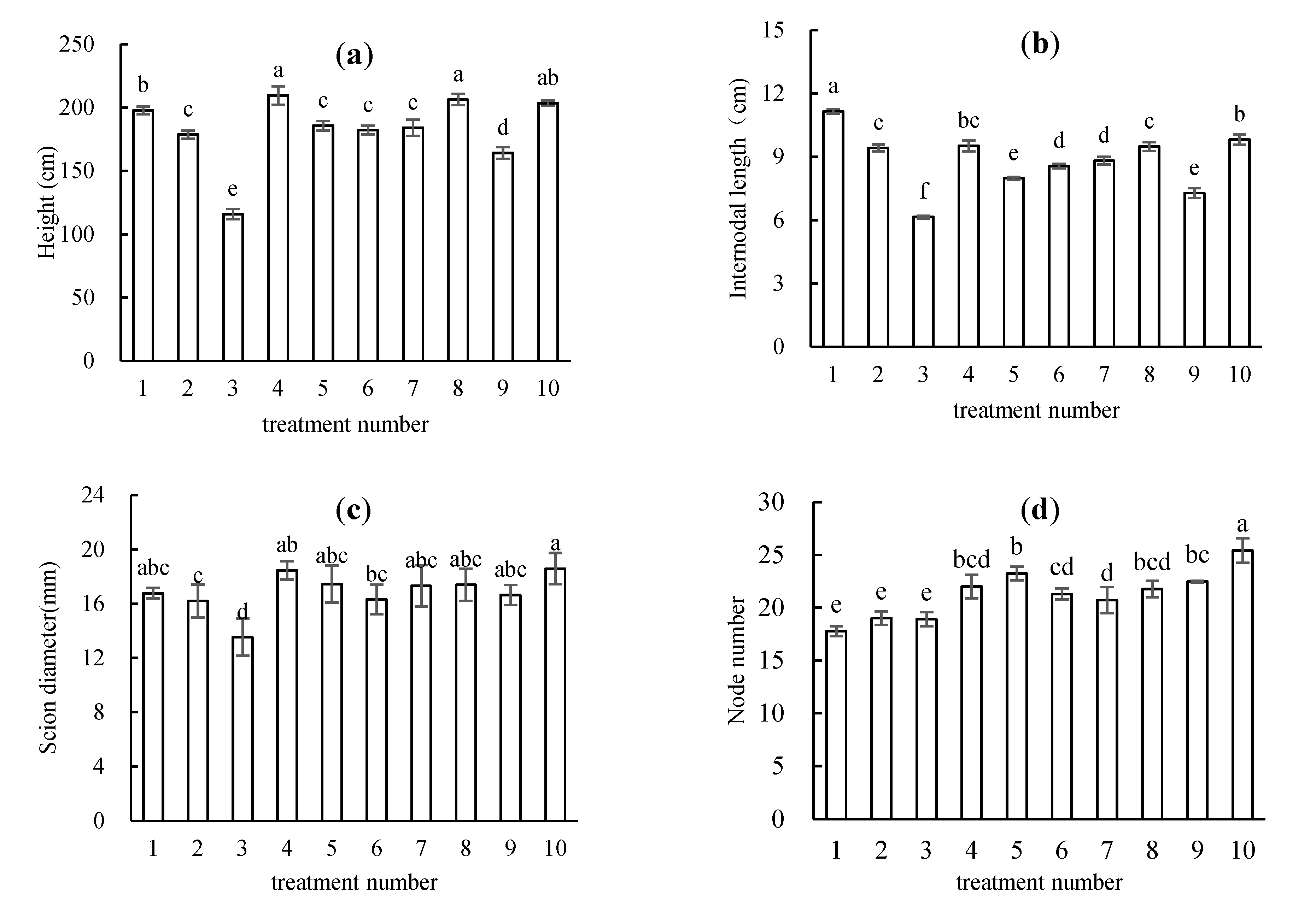
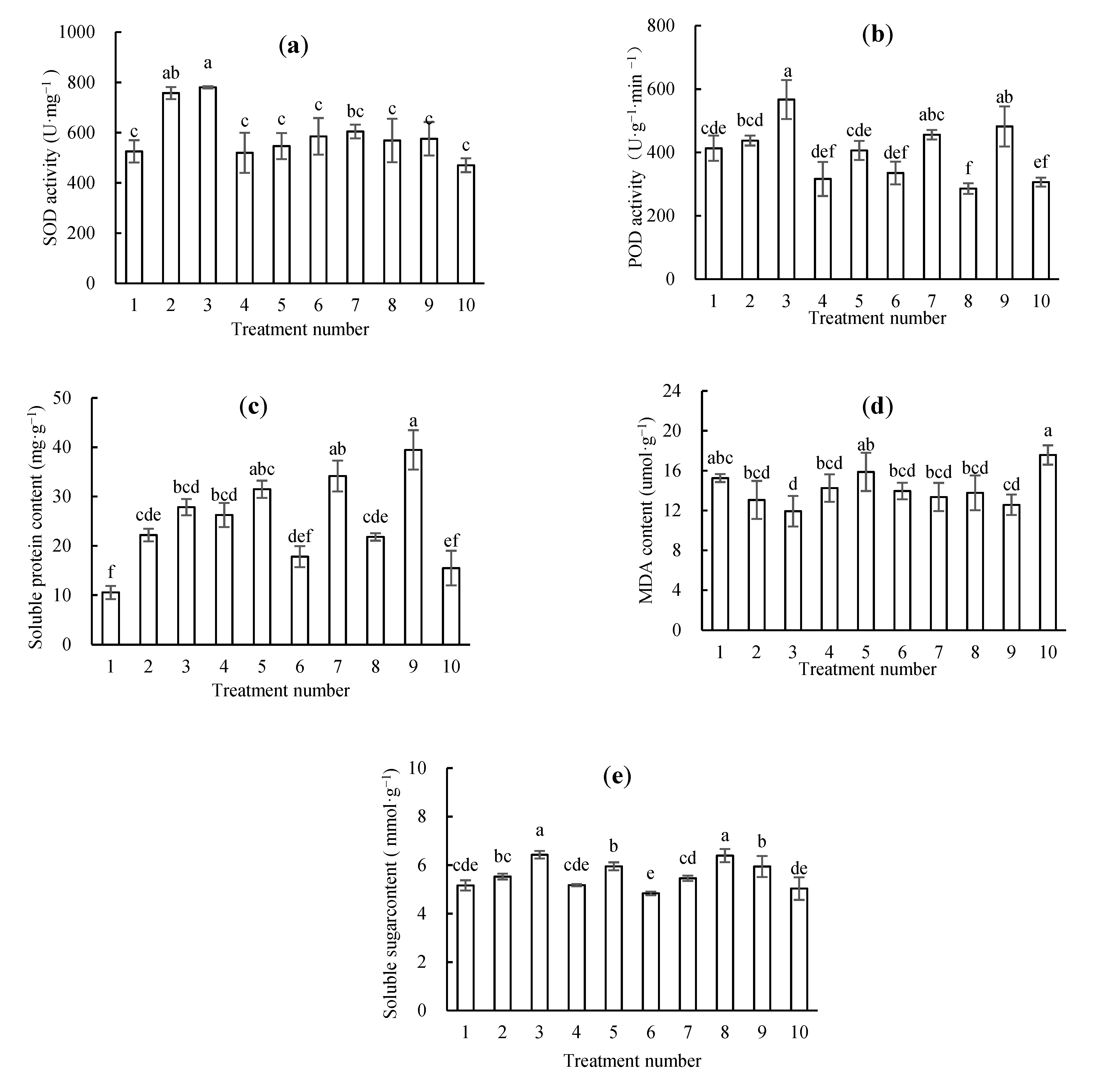
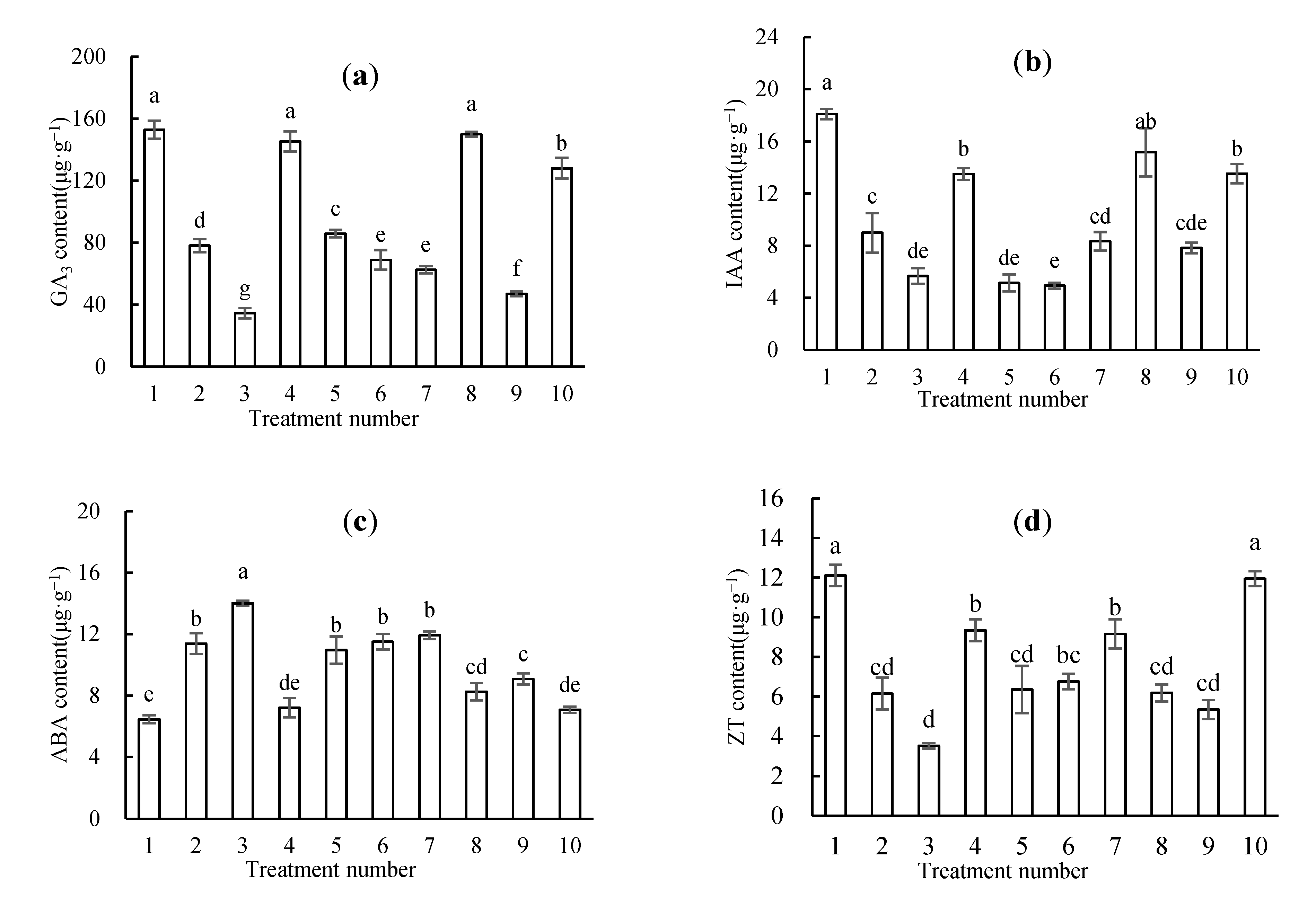
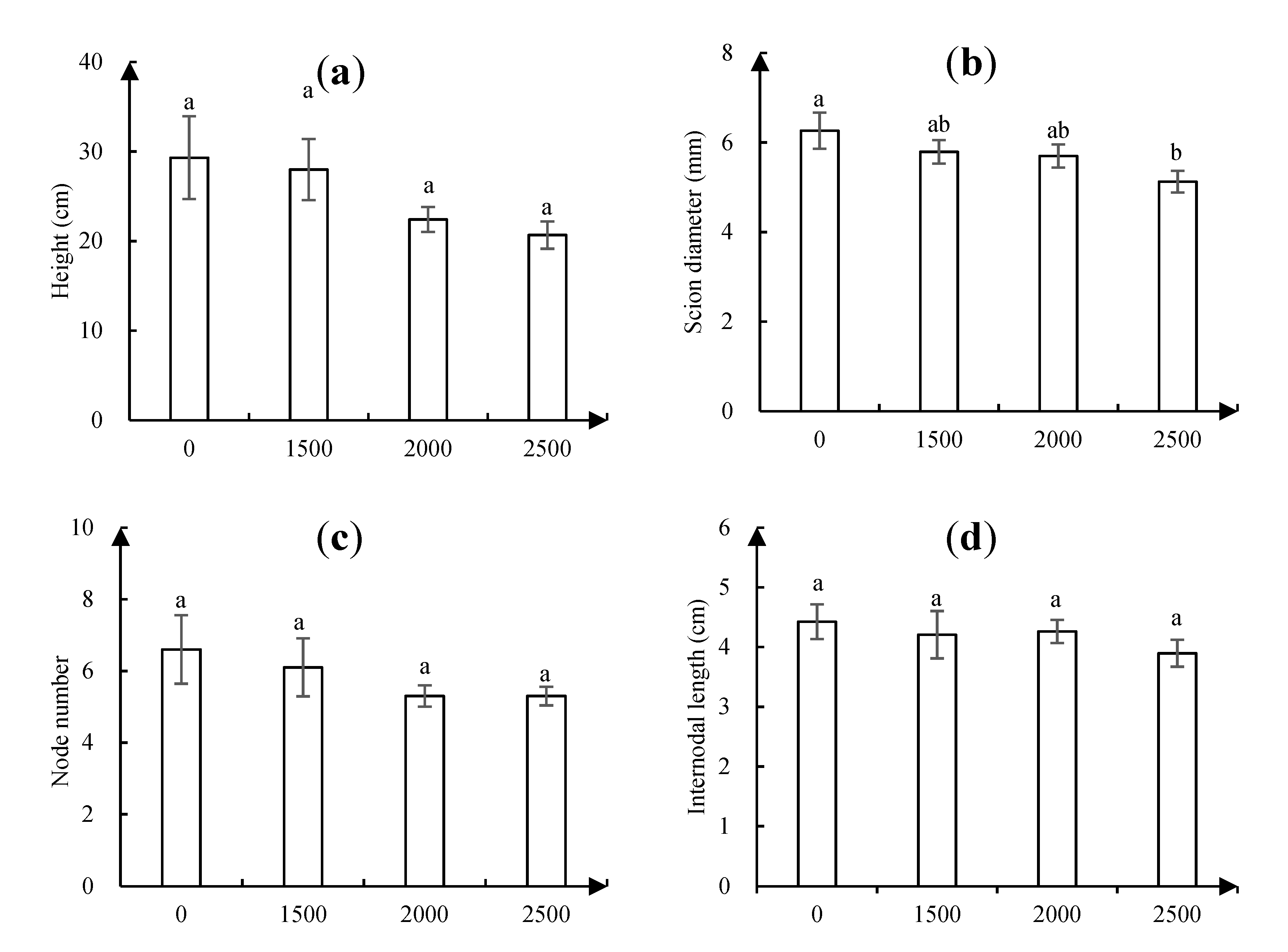
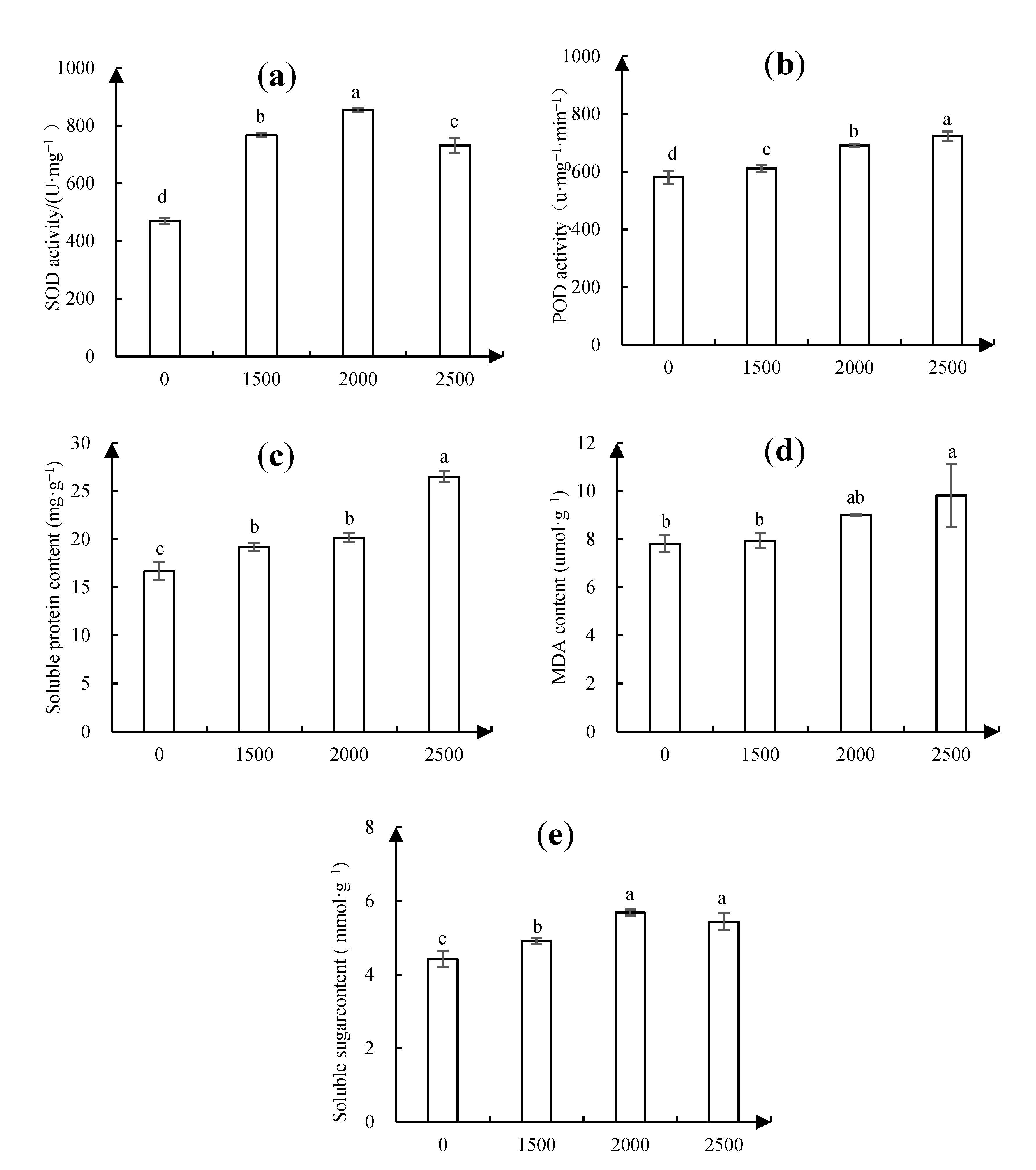
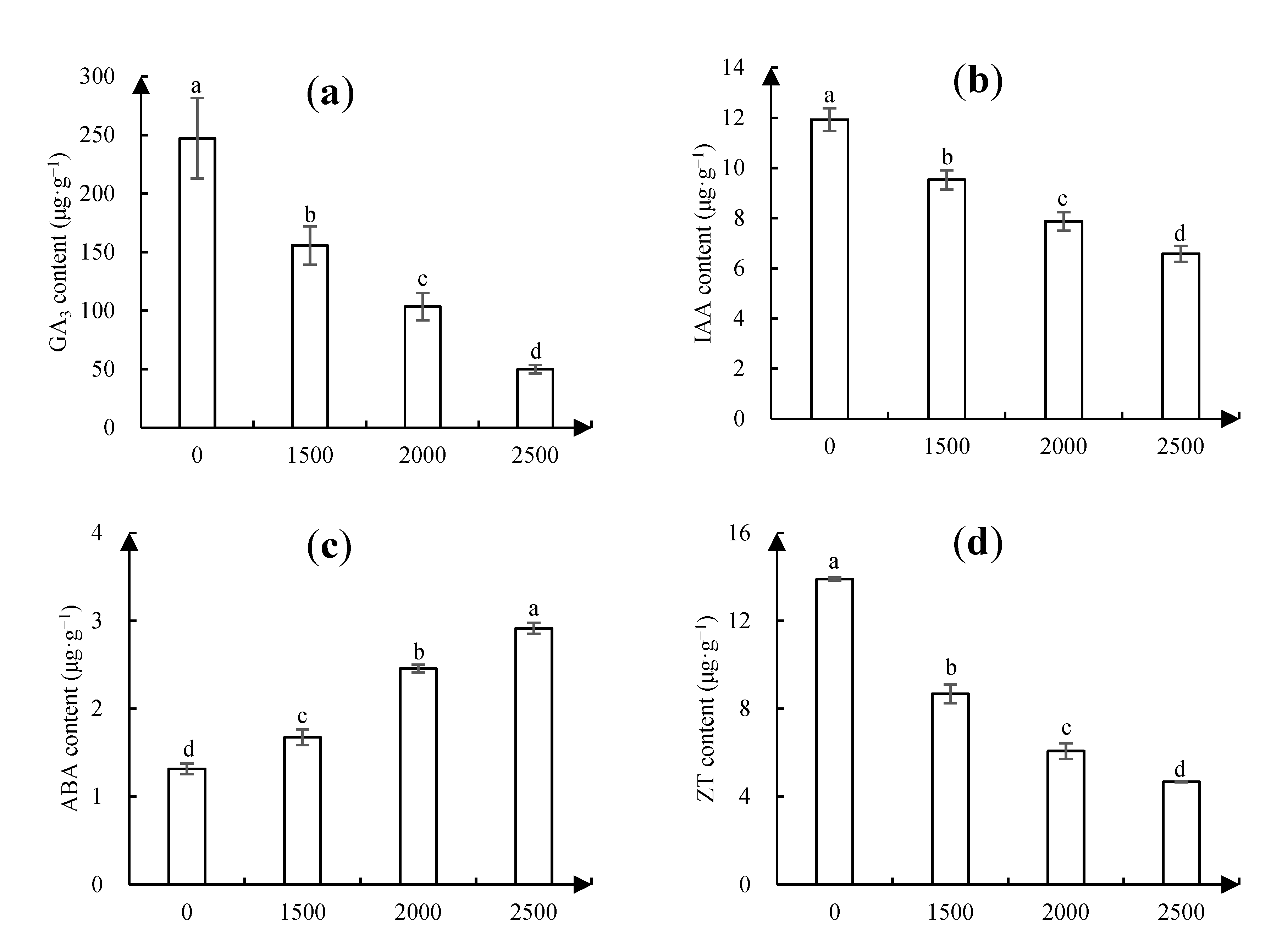
| Treatment Number | Variety | Concentration (mg·L−1) | Number of Application (Times) | Empty Column |
|---|---|---|---|---|
| 1 | Uniconazole | 500 | 1 | 1 |
| 2 | Uniconazole | 1000 | 3 | 2 |
| 3 | Uniconazole | 1500 | 5 | 3 |
| 4 | Paclobutrazol | 500 | 3 | 3 |
| 5 | Paclobutrazol | 1000 | 5 | 1 |
| 6 | Paclobutrazol | 1500 | 1 | 2 |
| 7 | Prohexadione Calcium | 500 | 5 | 2 |
| 8 | Prohexadione Calcium | 1000 | 1 | 3 |
| 9 | Prohexadione Calcium | 1500 | 3 | 1 |
| Range | Height/cm | Internodal Length/cm | Scion Diameter/cm | Node Number |
|---|---|---|---|---|
| Variety | 28.3 ** | 0.4 | 1.9 ** | 3.6 ** |
| Concentration | 43.1 ** | 2.5 ** | 2.0 ** | 1.2 * |
| Times | 33.6 ** | 2.1 ** | 1.0 | 0.9 |
| Range | SOD | POD | Soluble Protein | MDA | Soluble Sugar |
|---|---|---|---|---|---|
| Variety | 137.4 * | 12.8 | 11.6 ** | 1.5 | 0.6 * |
| Concentration | 74.3 | 34.9 | 4.7 | 1.1 | 0.7 ** |
| Times | 84.2 | 131.6 * | 14.4 ** | 1.4 | 0.5 * |
| Range | GA3 | IAA | ABA | ZT |
|---|---|---|---|---|
| Variety | 13.6 | 3.1 * | 0.9 | 0.6 |
| Concentration | 70.1 ** | 7.2 ** | 3.0 ** | 5.0 ** |
| Times | 63.0 ** | 6.3 ** | 3.6 ** | 2.0 ** |
Publisher’s Note: MDPI stays neutral with regard to jurisdictional claims in published maps and institutional affiliations. |
© 2020 by the authors. Licensee MDPI, Basel, Switzerland. This article is an open access article distributed under the terms and conditions of the Creative Commons Attribution (CC BY) license (http://creativecommons.org/licenses/by/4.0/).
Share and Cite
Shi, X.; Chen, S.; Jia, Z. The Dwarfing Effects of Different Plant Growth Retardants on Magnolia wufengensis L.Y. Ma et L. R. Wang. Forests 2021, 12, 19. https://doi.org/10.3390/f12010019
Shi X, Chen S, Jia Z. The Dwarfing Effects of Different Plant Growth Retardants on Magnolia wufengensis L.Y. Ma et L. R. Wang. Forests. 2021; 12(1):19. https://doi.org/10.3390/f12010019
Chicago/Turabian StyleShi, Xiaodeng, Siyu Chen, and Zhongkui Jia. 2021. "The Dwarfing Effects of Different Plant Growth Retardants on Magnolia wufengensis L.Y. Ma et L. R. Wang" Forests 12, no. 1: 19. https://doi.org/10.3390/f12010019
APA StyleShi, X., Chen, S., & Jia, Z. (2021). The Dwarfing Effects of Different Plant Growth Retardants on Magnolia wufengensis L.Y. Ma et L. R. Wang. Forests, 12(1), 19. https://doi.org/10.3390/f12010019





